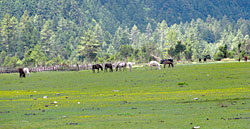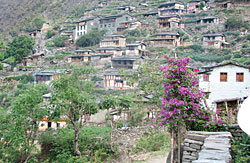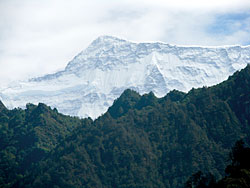 KISHOR RIMAL |
Led by the present Maoist PLA Commander, Nanda Kishore Pun (Pasang), the guerrillas probably were not in the mood to admire the scenery. More than 100 people were killed in the Battle for Beni as the fighting raged all night in the district capital of Myagdi.
The Maoists carried their wounded and walked back to Rukum and Rolpa, with the army in hot pursuit. They were bombed from the air by helicopters and suffered serious casualties.
 |
All along, there are spectacular views of the Dhaulagiri range from high ridges and large meadows fringed by pine forests.
Says Kuber Bista of the Nepal Tourism Board: "The trail has a historic attraction, but there are also challenges of infrastructure and making locals aware of how they can benefit from tourism."
NTB is partnering with the National Trust for Nature Conservation and the local Jaljala Tourism Development Committee to popularise the Rukum trekking route from the coming autumn season.
DAY 1: Kathmandu-Beni (8 hours by bus) 
DAY 2: Beni to Takam (6 hours)
From the Myagdi district headquarter you follow a gravel road for 24km to Darbang and start walking. Takam is three hour walk away with Gurja Himal towering overhead.
DAY 3: Takam to Lamsung (6 hours) 
This is where the scenery starts getting even more dramatic. This is what Nepal used to be like before the trekkers got here. Locals are not used to foreigners and have a lot of stories to tell about the war.
DAY4: Lamsung to Gurjaghat (7 hours)
Climb through dense pine forests, with musk deer darting in the undergrowth. The meadows on the ridge offer
180 degree views of Dhaulagiri and entire range up to Churen Himal in the west.
DAY 5: Gurjaghat to Dhorpatan (5 hours) 
You cross over from Myagdi to Baglung and into the former Tibetan refugee camp which was serviced by an airfield built by the Swiss in the 1950s. This is also the entrance to the Dhorpatan Hunting Reserve, where shooting mountain goats and blue sheep is now allowed for fee-paying professional hunters from all over the world.
Day 6: Dhorpatan to Nisi Dhor (5 hours)
This is the paradise for birds. Watch danphes, pheasants, and other migratory species that you have seen only in bird guides. Hard to imagine that people fought a war here. There are cow sheds in the monsoon, but in winter these high pastures are deserted.
DAY 7: Nisi Dhor to Tallo Sera (7 hours) 
Cross over from Baglung to Rukum into Magar country and enter the former Maoist base area. There are dense forests all the way so it must have been easy to hide here from the helicopter patrols. The villages are picturesque and there is always some kind of Magar festival going on.
DAY 8: Tallo Sera Rujhikhola (6 hours) 
Walk to Lukum in Rukum, a village populated only by Magars and Dalits. This is about as medieval as it gets in Nepal nowadays. Rujhikhola is where Pasang (now PLA commander) planned the Beni attack.
DAY 9: Rujhikhola to Thabang (5 hours) 
Thabang is the cradle of the Maoist revolution. It was damaged in army attacks and parts of the town were flattened by 'tora bora' mortars shells dropped from helicopters. There has been some development of infrastructure after the war ended, and the people are eager and friendly.
DAY 10: Thabang to Jaljale (5 hours)
The highest point in Jaljala is Dharampani (3,900m) and there is a great view from Api-Saipal in the west to Dhaulagri in the east. This is also where the PLA was given weapons training during the war.
DAY 11: Jaljala to Jelbang (6 hours) 
Now we're moving down from the high mountains and the villages are ethnically mixed.
DAY 12: (Jelbang to Suliochaur (6 hours)
This is where we finally get to Rolpa and the roadhead. Rolpa was also a rebel base area and for many of the ten years of war under total Maoist control. You can eat at one of many commune restaurants run by Maoist cooperatives, where staff are relatives of those who were killed in the fightings.
DAY 13: Sulichaur to Kathmandu (13 hours by bus)
Take a pillow.
More shooting
 |
Royalty from the hunting is supposed to go to the government, with permits costing anything between $10,000 to $25,000. A park ranger is supposed to accompany the hunters, who fly in by helicopter direct from Kathmandu, take the horns and depart.
However, there are complaints from the hunting expeditions who say that despite having paid the permit fees to the Department of National Parks and Wildlife, they are extorted by locals. VDC committees in Rukum and local Maoists in Baglung charge up to Rs 100,000 from expeditions. In a recent incident, Maoists exploded pipe bombs to scare away animals when they didn't get the amount they had demanded, said a villager.
The most coveted trophy is blue sheep, but hunters can also shoot Himalayan tahr and deer. Endangered animals like leopards, black bear, red panda, danphe pheasants, musk deer are out of bounds for the hunters.


